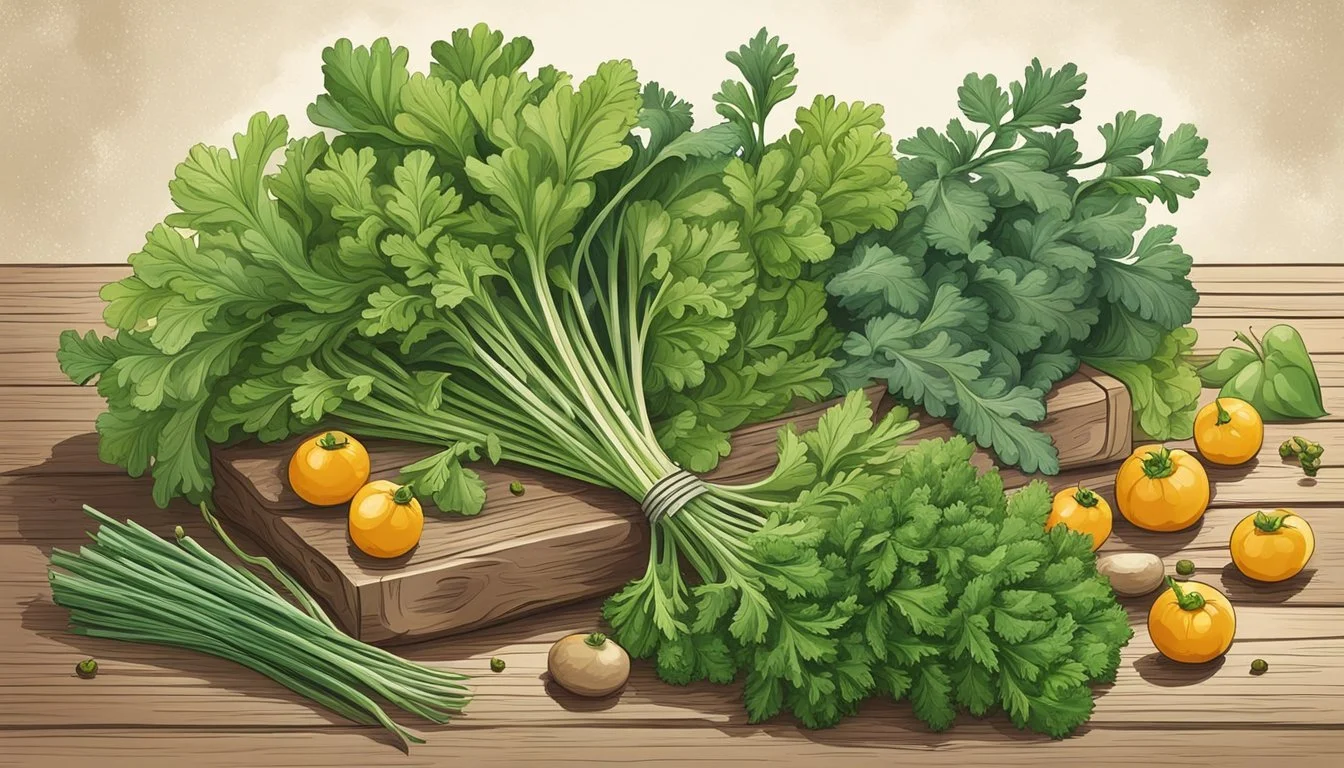What Are the Health Benefits of Chrysanthemum Greens?
Unveiling Nutritional Advantages
Chrysanthemum greens, known as shungiku in Japanese and garland chrysanthemum in some regions, are a nutrient-rich leafy vegetable prized in Asian cuisine for both its culinary versatility and health benefits. The greens have a slightly bitter and aromatic flavor profile, which lends a unique character to dishes such as salads, soups, stews, and hot pots. They are not only valued for their distinctive taste but also for their array of nutrients that contribute to overall health.
Rich in vitamins, minerals, and antioxidants, chrysanthemum greens are an excellent source of healthful compounds. They contain chlorogenic acid, carotene, flavonoids, vitamins A, C, and potassium, offering a spectrum of benefits. Regular consumption of these greens may contribute to improved cardiovascular health, weight management, and antioxidant protection. Additionally, the presence of dietary fiber supports digestive health while the low calorie count makes chrysanthemum greens an attractive addition to weight-loss diets.
Beyond their nutritional value, chrysanthemum greens have been associated with specific health advantages such as a reduced risk of lung cancer and anti-inflammatory properties. This aligns with a growing body of research that supports the inclusion of leafy greens in the diet for their potential to enhance wellness and prevent certain diseases. While these benefits are promising, incorporating a variety of vegetables in one's diet is essential for obtaining a full range of nutrients necessary for maintaining optimal health.
Nutritional Profile of Chrysanthemum Greens
Chrysanthemum greens, known for their nutrient density, are a valuable addition to a balanced diet. They provide essential vitamins and minerals while being low in calories and contain important macronutrients like fiber and protein.
Vitamins and Minerals Content
The vitamins and minerals in chrysanthemum greens contribute significantly to overall health. They are an excellent source of vitamin A and vitamin C, both of which are crucial for immune function and vision. In terms of minerals, these leafy greens are rich in potassium, essential for maintaining healthy blood pressure levels, as well as calcium and iron, which support bone health and the formation of red blood cells, respectively.
Vitamin A: Important for eye health and immune function.
Vitamin C: Known for its antioxidant properties and support of the immune system.
Potassium: Helps regulate fluid balance and muscle contractions.
Calcium: Essential for bone health and functioning of nerves and muscles.
Iron: Vital for blood production and transportation of oxygen in the bloodstream.
Macronutrients: Fiber and Protein
In addition to micronutrients, chrysanthemum greens are an important source of dietary fiber and protein. Fiber aids in digestion, contributes to feelings of fullness, and can help to manage blood sugar levels. Protein is essential for building and repairing tissues, and while chrysanthemum greens are not high in protein, they do contribute to the protein content of a meal, especially when combined with other protein sources.
Fiber: Essential for digestive health and can aid in weight management.
Protein: Plays a critical role in building and repairing the body's tissues.
Health Benefits of Consuming Chrysanthemum Greens
Chrysanthemum greens are not only a flavorful addition to various culinary dishes but also offer a multitude of health benefits. They are rich in nutrients that contribute to cardiovascular health, possess antioxidant properties, and support weight management and digestion.
Cardiovascular Health
Chrysanthemum greens contain nutrients that may positively affect heart health. Flavonoids, which are abundant in these greens, have been studied for their potential to lower blood pressure and reduce the risk of heart disease. These leafy greens help maintain cardiovascular health due to their chlorogenic acid content, a compound known to contribute to reduced blood pressure.
Antioxidant Properties
The high levels of antioxidants found in chrysanthemum greens, including carotenoids and flavonoids, protect the body’s cells from damage caused by free radicals. These antioxidants assist in neutralizing harmful molecules and may help in preventing chronic diseases. This makes chrysanthemum greens a valuable food for maintaining overall health.
Weight Management and Digestion
In weight management, chrysanthemum greens are a beneficial choice due to their low calorie yet nutrient-dense profile. They can enhance the feeling of fullness and decrease overall calorie intake, aiding in weight loss. Additionally, these greens are rich in dietary fiber, which supports healthy digestion and regular bowel movements.
Culinary Uses of Chrysanthemum Greens
Chrysanthemum greens, known for their grassy flavor and mild bitterness, enhance a variety of dishes in Asian cuisine, from leafy salads to robust hot pots.
Incorporating into Dishes
Chrysanthemum greens, also referred to as shungiku in Japanese cuisine, have found their place in a myriad of Asian dishes. They are often featured raw in salads, offering a fresh, crisp texture and a slightly bitter taste that complements the other salad ingredients. In Japanese cuisine, these greens are a staple in traditional hot pot dishes like sukiyaki and shabu-shabu, where they absorb the flavors of the broth while contributing their unique flavor and texture. Korean cuisine utilizes these greens in similar ways, underscoring the versatility of edible chrysanthemum across different Asian culinary traditions.
Salads: served raw for a crisp texture.
Hot pots: such as sukiyaki and shabu-shabu, where the greens are simmered.
Stews and Soups: used as a nutritious vegetable addition.
Preparation Techniques
The key to preparing chrysanthemum greens lies in the cooking time, as they can quickly turn from vibrant to overcooked. When cooked, they are typically briefly boiled, steamed, or stir-fried, often just for a few seconds to maintain their desirable texture and flavor.
Boiling/Steaming: Cooked for no more than 30 seconds to prevent them from becoming mushy.
Stir-frying: Quickly sautéed on high heat, often with garlic and a splash of light soy sauce and sesame oil for additional flavor.
Whether served raw as a garnish or cooked to enrich the dishes in China, Japan, or Korea, chefs and home cooks alike prize these greens for their versatility and the delicate balance they bring to recipes.
Potential Considerations
When incorporating chrysanthemum greens into a diet, it's important to be aware of dietary restrictions and potential allergic reactions, as well as understand the correct methods for storage and handling to maintain their quality and minimize waste.
Dietary Restrictions and Allergies
Chrysanthemum greens, related to the ragweed family, may pose a risk for individuals with allergies to ragweed or related plants. Symptoms can include inflammation, sneezing, or a rash. Those with severe sensitivities should consult with a healthcare provider before consumption. In terms of dietary restrictions, these greens are generally suitable for most diets, as they are low in calories and rich in nutrients.
Proper Storage and Handling
Proper storage of chrysanthemum greens is essential to prolong their freshness and prevent spoilage. They should be stored in a plastic bag in the refrigerator, which can keep them viable for about a week. When preparing the greens, one should use a knife with a serrated edge to maintain the integrity of the tender leaves and stems. Careful washing is also necessary to remove any dirt or residue before cooking.
Frequently Asked Questions
Chrysanthemum greens are recognized for their health benefits, from nutritional advantages to potential skin health improvements. This section addresses common inquiries about these leafy greens.
What nutritional advantages do chrysanthemum greens offer?
Chrysanthemum greens are rich in vitamins A, C, and K, and they contain essential minerals such as potassium, calcium, and magnesium. They are also a good source of dietary fiber.
How might consuming chrysanthemum greens affect overall well-being?
They offer antioxidants that help protect the body against oxidative stress and may support immune function. Regular consumption of chrysanthemum greens can contribute to overall health maintenance.
Can chrysanthemum greens provide skin health benefits?
These greens contain antioxidants and anti-inflammatory properties that may benefit the skin by protecting it from damage caused by free radicals and reducing inflammation.
Are there any potential negative effects of eating chrysanthemum greens?
Some individuals may experience allergic reactions to chrysanthemum greens. Overconsumption might also lead to stomach upset due to their high fiber content.
In what ways can chrysanthemum greens contribute to hair health?
The vitamins and minerals in chrysanthemum greens are beneficial for hair health, potentially strengthening hair follicles and promoting hair growth.
What is the optimal consumption time for chrysanthemum tea to maximize its health benefits?
Drinking chrysanthemum tea during evenings can be optimal as it has calming properties that may aid in relaxation and sleep. However, personal preferences and health conditions should be considered.






